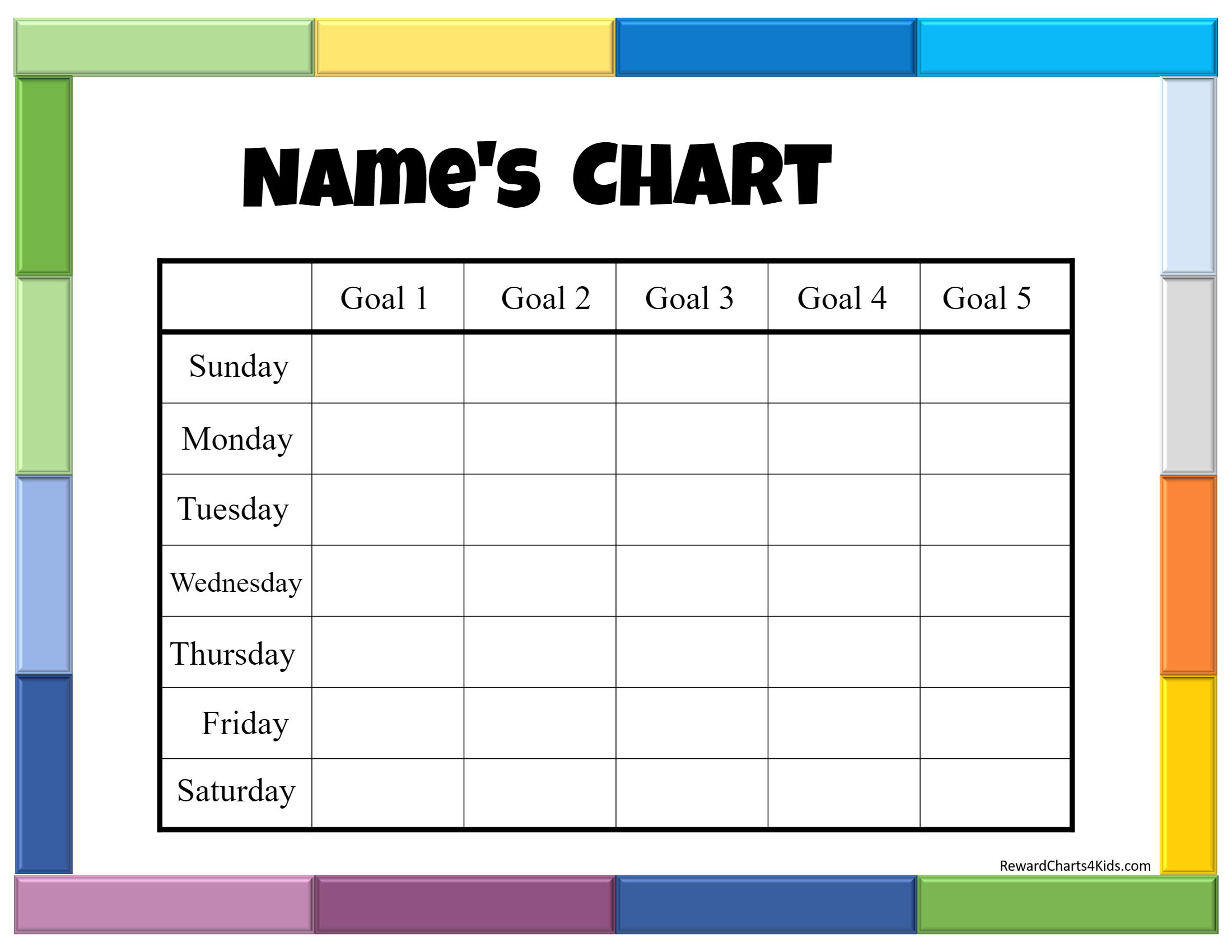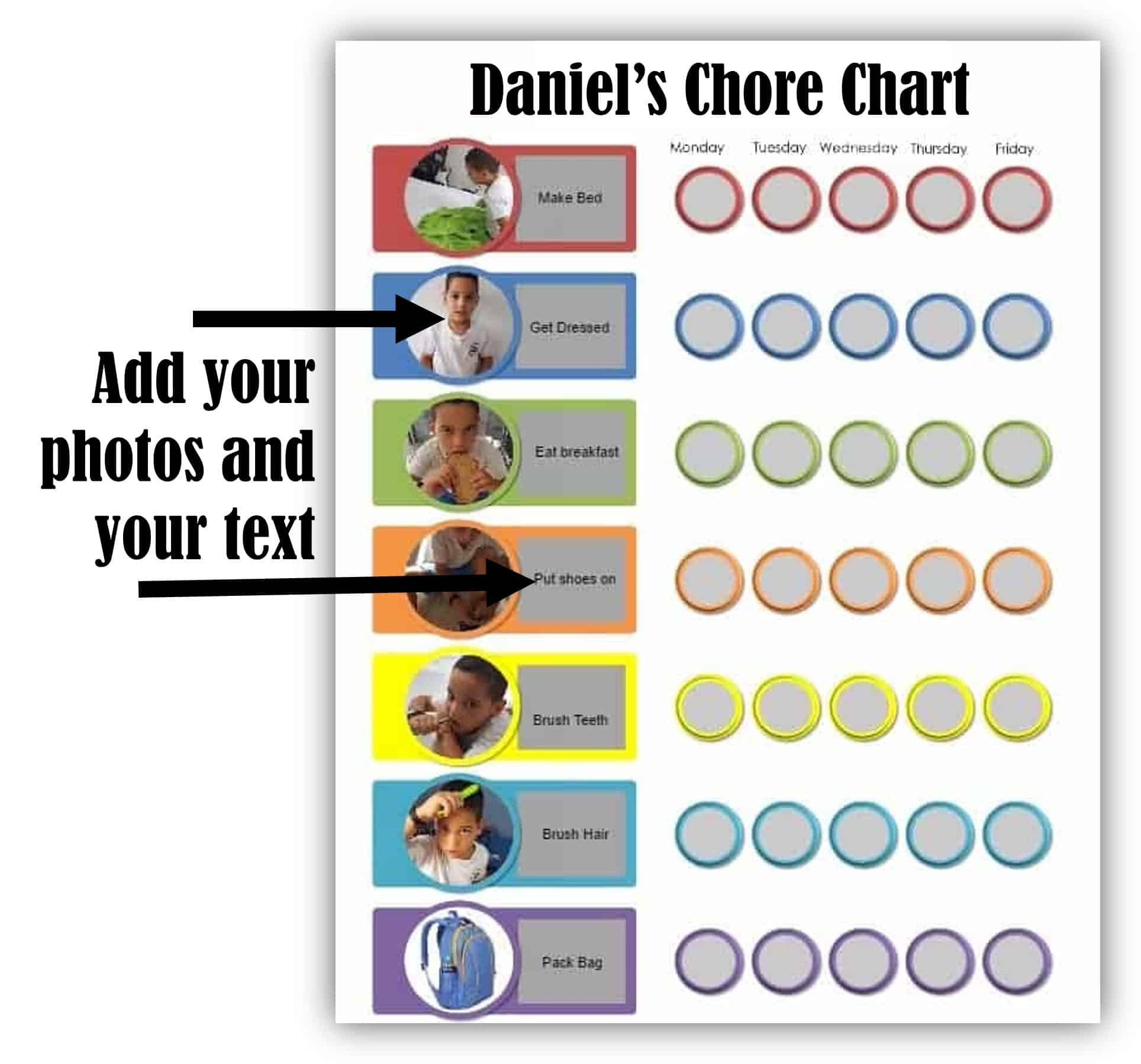Toddler Reward Chart
Find the perfect behavior chart for you and your toddler with our selection of free, customizable templates, designed to encourage positive behavior, establish routine, enhance communication, potty train, and help you maintain consistency in parenting.
You can add any border, photos or clipart, and edit the text. The possibilities are endless.
What is a Behavior Chart for Toddlers?
Behavior charts are visual tools used to help toddlers understand the link between behaviors and outcomes. They typically consist of a chart with symbols or stickers that represent a child’s behavior over a period of time. The primary purpose of these charts is to encourage positive behavior through a system of rewards. For toddlers, who are just beginning to understand the basics of cause and effect, behavior charts simplify this concept, making it easier for them to grasp the consequences of their actions, both positive and negative.
Benefits of a Toddler Behavior Chart
Behavior charts for toddlers offer several key benefits:
- Structure and Routine: Toddlers thrive with predictable routines, and behavior charts reinforce daily expectations.
- Visual Motivation: The visual nature of the charts makes it easy for toddlers to see progress and understand goals.
- Positive Reinforcement: These charts emphasize positive behavior, fostering a positive learning environment rather than focusing on punishment.
- Development of Self-Discipline: Regular use of behavior charts helps toddlers develop self-control and responsibility over time.
- Enhanced Communication: Charts provide a basis for parents and toddlers to discuss behaviors and expectations clearly and consistently.
Age Appropriateness
When Can You Start Using Behavior Charts?
Behavior charts can be effectively introduced when a child is around 2 to 3 years old. This is the age when toddlers begin to understand simple instructions and can start to grasp the concept of rewards. It’s also a critical period for setting the groundwork for discipline and self-regulation.
How Understanding Developmental Stages Can Help Tailor the Chart to a Toddler’s Capabilities
Understanding a toddler’s developmental stages is crucial for creating an effective behavior chart. At this age, toddlers are developing their language skills and can follow two-step instructions. Charts should therefore be simple, with clear, easily recognizable images that represent desired behaviors. Parents should focus on one or two behaviors at a time to avoid overwhelming their child. Some of our sticker charts come with an option to add images that visually represent the desired behaviors for your toddler, making it easier for them to understand and follow along. Even for charts that don’t initially include this feature, you can easily add photos to any chart by clicking on “Add Image” in the chart maker. This allows you to customize the chart fully to meet your specific needs and visually reinforce positive behaviors for your toddler.
Setting Goals
How to Choose Appropriate and Achievable Goals for Toddlers
When setting goals for toddlers, choose behaviors that are developmentally appropriate and within their capability to change. For instance, goals like “saying please or thank you” or “put toys away after play” are achievable for toddlers with consistent reminders. The goals should be framed positively, indicating what to do rather than what not to do.
Importance of Clear, Simple, and Specific Behaviors to Encourage
Clarity is key when communicating the expected behaviors to toddlers. The behaviors targeted should be specific, such as “sharing toys with friends” or “saying please and thank you.” This specificity helps toddlers understand exactly what is expected of them, reducing confusion and helping them achieve the goals set out on the chart, which in turn boosts their confidence and willingness to participate.
Using the Sticker Chart
Guidelines on Introducing the Reward Chart to Your Toddler
Introducing a reward chart to a toddler should be done enthusiastically and positively. Show excitement about the chart and explain that it’s a special way to see how well they are doing with their daily activities. Place the chart at eye level for the toddler so they can easily see and interact with it. Initially, guide them through the process, pointing out when they exhibit a behavior that gets a sticker or mark on the chart.
How to Explain the Rules and Rewards in a Way that Toddlers Understand
Use simple, concrete language when explaining the behavior chart to your toddler. For each behavior, describe clearly what is expected. For example, “If you put away your toys, you get to put a sticker here!” Emphasize the positive outcomes of their good behavior, linking it directly to the visual reward on the chart. Be consistent in your explanations and repeat them as needed to reinforce understanding.
Choosing Rewards
Ideas for Age-Appropriate Rewards that Motivate Toddlers
Rewards for toddlers should be immediate and tangible, often, simply receiving a sticker on their chart is a sufficient and exciting reward for them. The act of placing a sticker can be highly satisfying and serves as a visual confirmation of their accomplishment. However, if you find that additional incentives are needed, consider offering a reward once they complete their chart. This could be an extra bedtime story, a favorite snack, or a small toy—something that your toddler eagerly anticipates. Moreover, experiences like a trip to the park or special playtime with parents can be especially motivating and are excellent ways to promote bonding while reinforcing positive behaviors.
Balance Between Intrinsic and Extrinsic Motivation
While behavior or reward charts focus on extrinsic rewards, it’s important to foster intrinsic motivation by praising the effort and positive behaviors that led to the reward. Highlight the feelings of pride and accomplishment, saying things like, “You must be so proud of yourself for sharing your toys so nicely!” This encourages toddlers to value the behavior itself, not just the reward. One of the key benefits of using a reward chart is that it serves as a consistent reminder for parents and caregivers to express positive reinforcement. Each time you place a sticker on the chart, it’s an opportunity to offer praise. This routine helps ensure that commendation is not overlooked in daily activities, reinforcing the positive interactions and affirming the behavior you want to encourage.
Consistency and Follow-Through
The Importance of Consistency in Using the Chart
Consistency is key in making behavior charts effective. Toddlers learn best through routine and predictable outcomes. Make sure to consistently acknowledge when a behavior meets the criteria set on the chart and immediately provide the reward or sticker. This helps reinforce the learning and behavior pattern.
How Parents and Caregivers Can Ensure They Consistently Follow Through with Rewards and Acknowledgments
Set reminders for yourself if necessary, to check the chart at specific times during the day. Always have a supply of rewards (such as colorful stickers) ready, and involve other caregivers in the process to maintain consistency across different environments, such as home and daycare.
Troubleshooting Common Challenges
What to Do if Your Toddler Loses Interest in the Chart
If interest wanes, it might be time to refresh the reward chart with new goals or rewards. Ask your toddler what they would like to work towards to re-engage them in the process. Sometimes, simply changing the appearance of the chart or the type of stickers used can renew interest. Consider revisiting this site and creating a new sticker chart together with your toddler. Encourage them to choose the background and the clipart. This involvement not only ensures they like the chart but also boosts their interest and engagement.
How to Adjust the Chart as Your Toddler Grows and Their Behaviors Change
As toddlers grow, their capabilities and interests will change. Regularly review and update the behavior chart to reflect more mature expectations and new developmental milestones. For example, as a toddler becomes more adept at verbal communication, you might shift focus from simple behaviors like “not hitting” to more complex ones like “using words to ask for a turn.”
Age Appropriate Charts for Toddlers
On this site, you have access to a variety of free behavior charts specifically designed for toddlers. Each chart is crafted to target crucial areas of a toddler’s daily life and development, such as bedtime routines, emotional regulation, and potty training.
Bedtime Chart for Toddlers
A toddler bedtime routine chart helps establish a soothing nighttime routine, which is crucial for toddlers who are learning about daily structures. This chart can include steps like putting on pajamas, brushing teeth, reading a bedtime story, and lights out. By visually tracking these activities, toddlers can gain a sense of security and accomplishment as they prepare for sleep each night.
Click on the “Routine Chart” filter above see our bedtime routine charts. We even have a chart where you can include a photo of your toddler doing each of these steps.
Toddler Emotions Chart
Understanding and managing emotions can be challenging for toddlers. A feeling chart for toddlers helps them recognize and name their feelings, a vital step in emotional development. This type of chart typically uses simple facial expressions to depict different emotions like happiness, sadness, anger, and fear. It encourages toddlers to express their feelings in a healthy way, aiding parents and caregivers in responding appropriately to the child’s emotional needs. See our free feelings charts.
Potty Chart
Potty training is a significant milestone for toddlers and can benefit greatly from the use of a behavior chart. A potty chart tracks attempts and successes, providing positive reinforcement each time the toddler uses the toilet. This chart can include fun stickers or marks for each successful potty use, helping to motivate the toddler and reduce any anxiety associated with potty training.
Click on the “Potty Chart” filter above see our free potty training charts for toddlers.
Toddler Chore Chart
Design a chore chart to guide your toddler through daily responsibilities in a fun and understandable way. With our chore chart, you can upload photos of each task, such as brushing teeth or tidying up toys, making it easier for your toddler to recognize and follow through with each chore. This visual method not only simplifies the understanding of tasks but also encourages a sense of achievement as they complete each one.
Click on the “Chore Chart” filter above see our free chore charts for toddlers.
Sleep Reward Chart
Download a sleep reward chart to encourage healthy sleep habits for your toddler. This chart can target goals such as settling down quietly, staying in bed all night, and waking up at the right time. Each successful night can be marked with a sticker or a star, providing a visual representation of their progress and making bedtime routines more rewarding and motivating for your child.



























